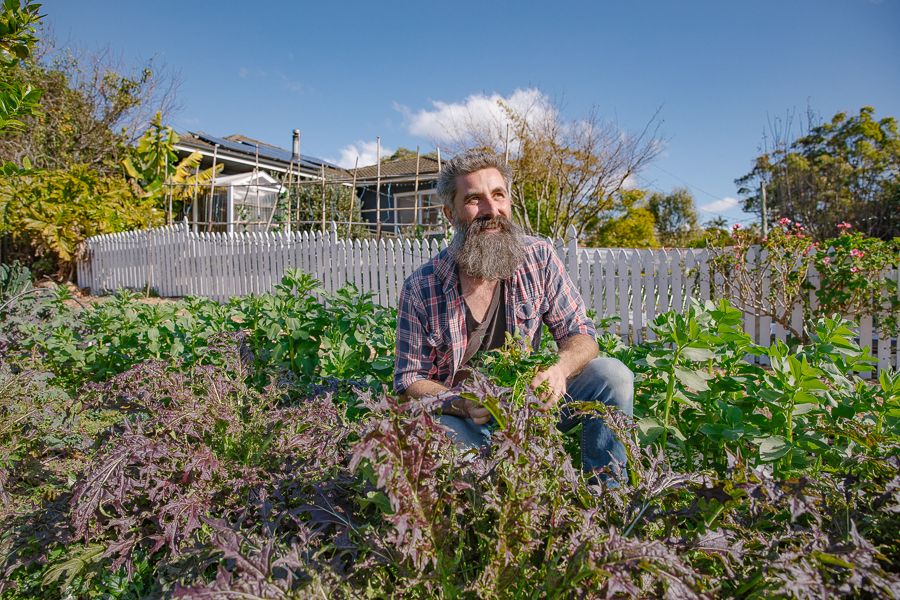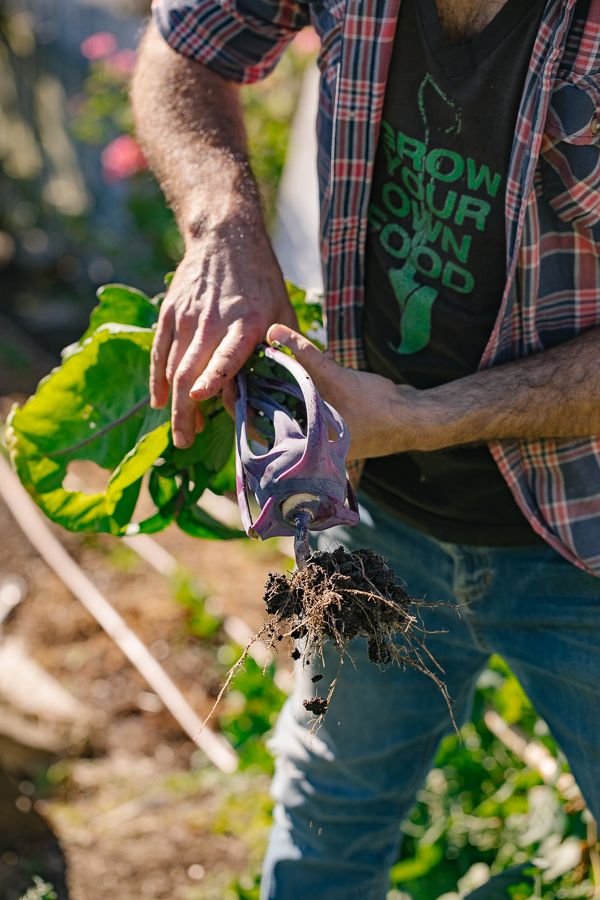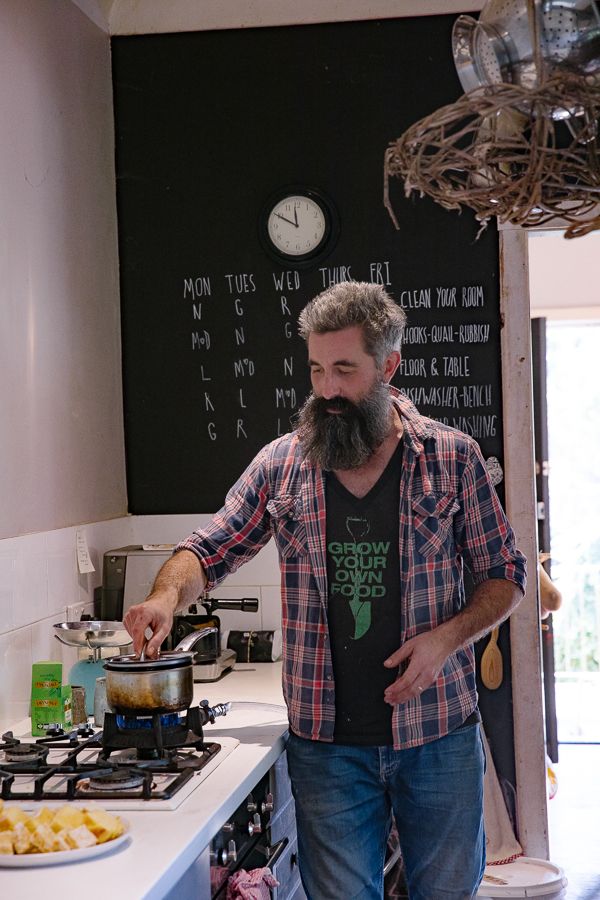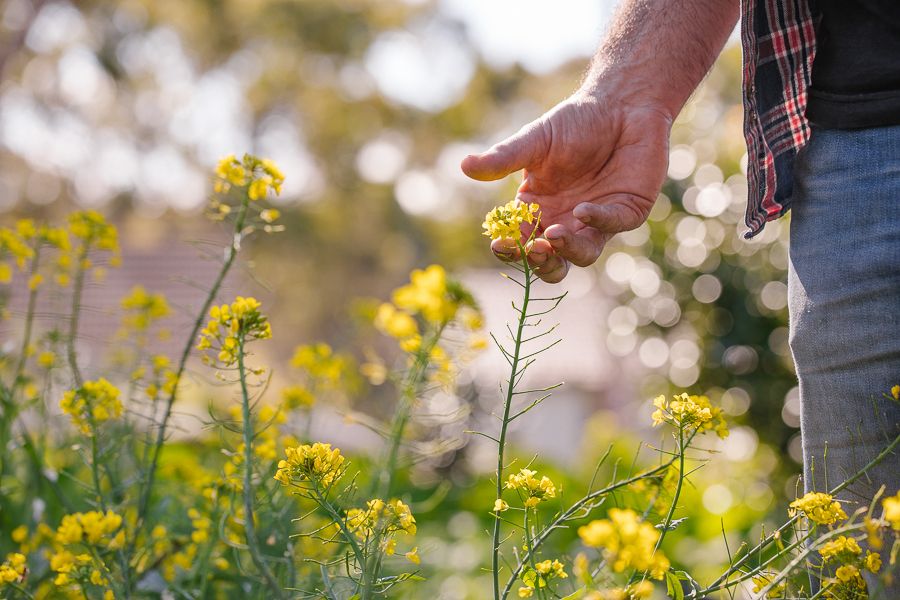
Closing the loop means two things to organic gardener Joe Tabone: community and compost. Jacqueline Forster caught up with the Springwood micro-farmer to learn how he incorporates both into his abundant suburban garden.
When Joe Tabone moved to Springwood, in the New South Wales Blue Mountains, he knew he wanted to grow food, but would he be able to grow enough to feed his family and how could he close the loop in an urban setting?
“We’d been dabbling in food growing at our rental in the city, so we began with a similar model of raised beds,” Joe explains. It wasn’t long before Joe realised he wanted a lot more than a few raised beds. Twelve years down the track, Joe runs a micro farm, Urbavore Blue Mountains, (with wife Jo and five kids) that not only feeds the family but supplies fruit and veg to restaurants and co-ops, and weekly vegie boxes for the local community.
“It certainly has evolved,” says Joe. Almost the entire 700 metre square block including the sub-floor and verge is now given over to food production. A polytunnel and greenhouse situated on the old driveway goes to show that if you have spare space, you can turn it into productive space.
Growing movement

Springwood is known for its ideal temperate climate which gives Joe the flexibility to grow a large variety of fruit and veg. “We can grow apples here and we have done bananas too,” he says. Of course, there are pros and cons like fruit fly, but Joes says the main benefit is a long growing season.
Over winter he grows loads of parsley, thyme, oregano, chives, rainbow chard, silverbeet, collard greens, snow peas, garlic, carrots, kale, beetroots, turnips, and spring onions. And in summer it’s tomatoes, cucumbers, capsicums, beans, corn, pumpkin, and other heat-loving crops. Fruit trees, mushrooms and microgreens are also cultivated.
During lockdown in 2020 Joe expanded the verge garden using biointensive methods. “We put in a lot of organic matter, cultivated the soil with a broad fork and interplanted each row with the intention of suppressing weeds and maintaining continuous cropping. “It’s amazing how much you can produce by “ever-bedding”: getting two crops out of one bed in the same space and time.”
“We interplanted garlic with radishes and before we harvest the lettuce we’ll interplant with zucchini or cucumber. The goal is to never have a bed that’s empty or bare.”
Joe also saves as much seed as he can to reduce inputs. “Saving your own seed conditions your crops to your environment and increases the resilience of your system.”
Inside the greenhouse hot compost is used to help germinate seedlings. “We sit seedling trays directly on top of the compost and cover them to trap moisture. The combination of heat and moisture really improves germination.” About a cubic metre of hot compost is enough to generate heat for several weeks.
Joe uses cover crops such as wheat, broad beans, and peas as a green manure to feed the soil biology over winter. “In early spring we crimp the beds and might tarp them for a few weeks to kill off the cover crop, then we can put out tomatoes. It not only feeds the soil but provides a good mulch layer and helps reduce weeds.”
Community connections

From the start Joe’s neighbours have been supportive of his urban farm aspirations. “We had an incredibly positive response from the neighbourhood when we started growing on the verge with several neighbours joining in planting fruit trees. We always wanted our food growing journey to involve community; having the verge garden makes people feel welcome and have a sense of ownership.
“On an urban scale you’ve got to think beyond your fence. For us, a closed loop system means working with what we have locally available. Our neighbours give us their grass clippings and other bio waste and in return they are welcome to come and pull a few carrots or beetroot.”
Indeed, much of the farm’s organic inputs come from the local community including arborists mulch, coffee grounds from cafes, cardboard from shops, and brewery waste from the local micro-brewery.
In autumn, Joe staged a leaf amnesty to prevent autumn leaves ending up in green waste bins. “We have so many beautiful deciduous trees in the Blue Mountains that are a fantastic source of carbon, so I put the word out on social media for donations and got trailer loads.”
Put to good use as a deep litter in the chook pen the leaves will break down by spring when Joe can use them on the garden beds. “It’s a slower form of composting but absorbs the high nitrogen chook manure and keeps the odour of the hen house down.”
For the birds

The use of poultry in Joe’s system is integral. “We’ve taken the large-scale agricultural concept of rotational grazing and applied it to our micro farm,” he says. Using a mobile cage customised to fit the length and width of his beds, Joe uses quails to graze down crops after harvesting. “The quail eat the remaining greens, drop their manure, and clean up slugs and other pests. After a week or two we move them onto another bed, put down a layer of compost and plant straight into that.”
A dozen or so Light Sussex and Isa Brown chooks also provide eggs, meat, and manure. “Chooks are the most efficient way of processing waste into nutrients that you can cycle back into the garden or the compost heap,” says Joe. “We eat and sell the eggs and process our own chooks and quails.”
“Growing your own meat is contentious but it is worth discussing,” he says. “I understand the popularity of the vegan movement and the need for more ethical meat production on a larger scale but in an urban environment you can produce a significant volume of your own meat.”
“Quail are great because they are fast growing; you can process them within eight weeks.” Joe selects the largest quail for line breeding, incubates and hatches them. “We keep the females for their eggs and to put out on pasture for a couple of seasons and process the males.”
And on this micro farm even that is a family affair. “All the kids (Noah 15, Georgia 12, Rosie 10, Lola 8, and Banjo 2) are involved in one way or another and have been doing farm chores since they were small including feeding, plucking, and gutting the birds.”
“When the kids eat meat we’ve grown they are much more particular about not wasting it because they understand the whole process and what’s gone into it.”
Cooking with gas

Inspired by Kevin McCloud’s experiment to generate energy from bio-waste in his series Man Made Home* Joe built his own biogas generator. “The idea that poo, weeds and kitchen scraps could be fermented to produce power was gross but fascinating.”
He explains the process: “We filled an IBC (intermediate bulk container) tank with water and fresh horse manure. The bacteria naturally found in a horse’s gut breaks down the organic matter that we feed into the tank and produces gas. We capture this biogas in another floating IBC which rises as it fills with gas. To keep the digester warm and the fermenting process active we set up a hot compost bay right next to the tank which is also black to capture radiant heat. The ferment is most active at around 40-50 degrees Celsius, so we produce most gas in summer but still enough in winter to cook on about two to three times a week.”
The biogas is plumbed straight into the kitchen. “We still use gas from the grid but it’s incredibly satisfying and good fun to cook with fuel you’ve generated yourself. It’s a really clean fuel and you’ve got an endless supply if you keep feeding it.”
A by-product of the biodigester is a nutrient dense liquid slurry which is diluted and used as fertiliser in the vegie patch. “The cucumbers went insane last summer when we fed them with it,” says Joe. “It’s great for fruit trees, heavy feeders and anything with a long harvest like kale and pick and come again crops.”
End game

Joe is philosophical about sustainability. “Closing the loop doesn’t just relate to the nutrient cycle within the area you’re growing, you’ve got to look at the bigger picture. Large scale agriculture is the antithesis of closing the loop with its high energy inputs and use of synthetic pesticides and fertilisers.
“One of the best ways people can help close the loop is to purchase from local growers and start growing more food themselves. We need to re-think the paradigms of what an urban space is supposed to look like.”
Recently retired from a 20-year teaching career, Joe is looking forward to expanding and refining his production systems and passing that knowledge onto others through workshops on composting, how to set up a micro farm, and vegie growing basics.
So, can you really feed a family from a suburban block? “If you asked me this question ten years ago, I would probably have said no, but once you get the right system and processes in place you find that you can produce a huge amount of food from a relatively small space.”
Meet your Local Farmer for Dinner
Blue Mountains Food Co-op, in collaboration with Lyttleton Stores Co-op, are proud to launch a series of local produce dinners beginning with Meet Your Local Farmer – Joe Tabone from Urbavore Blue Mountains. Guests will enjoy an intimate 3-couse meal featuring all local produce, wines by Frankly This Wine Was Made By Bob, and craft beverages, plus enjoy a talk by Joe.
Photos: Maja Baska Photography
This edited article first appeared in ABC Organic Gardener magazine and is reprinted with permission.
*iview.abc.net.au/show/kevin-mcclouds-man-made-home


